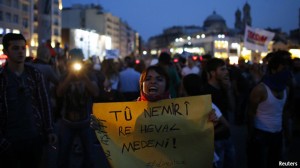THE mass anti-government demonstrations that have rocked Turkey over the past month are dying down and only now is the full horror of police abuse against protestors beginning to emerge. Human-rights groups say the use of tear gas as a weapon marks a new chilling trend among Turkey’s notoriously nasty riot police.
Hasan Kilicgedik, a thirty-year-old Kurd, was among the tens of thousands of people who took to the streets in protest of the Turkish prime minister, Recep Tayyip Erdogan, and his increasingly authoritarian ways. It was on June 16th somewhere near Taksim Square (pictured) where the unrest first erupted. Riot police started dousing him and fellow protestors with teargas. “Then amid the smoke I saw one come at me with his tear gas launcher and fire it directly at my head” Mr Kilicgedik recalled. “The gas canister hit my brow and cracked my skull and eye-socket, look,” he said pointing at an X-ray of his skull. “It’s a miracle that I survived.”
Berkin Elvan, a 14-year-old boy and Lubna al Lami, a 34-year-old Palestinian tourist who got ensnared in the violence may not be so lucky. Both remain in critical condition after being hit by teargas canisters. At least 8,000 people were wounded, eleven blinded by rubber bullets and four others killed (two from live bullets and two of heart attacks triggered by the inhalation of teargas) during clashes with the police. Scores have reportedly being hit by teargas canisters as a result of police taking deliberate aim at them. Emma Sinclair Webb of Human Rights Watch, a New York based watchdog group, confirmed that the police “had transformed teargas from its function as a means to disperse a crowd into a lethal weapon”.
Despite the abuse, not a single head has rolled, says Ms Sinclair Webb. Not only that, Mr Erdogan appears to be egging the police on. Speaking before a graduating class of the police academy on June 26th, Mr Erdogan said the police had “successfully carried out their duties within the confines of the law” and “passed a very important test of democracy”. According to Mr Erdogan they have “written a epic of heroism”.
Meanwhile, allegations of sexual harassment under detention are beginning to surface. Take the case of a 25-year-old student who was detained along with 73 others on May 31st even though they were not involved in the protests. The student, who asked not to be identified by name, said she and six other women were locked up by turn in a dark, grimy cell by a “large and evil looking” woman police officer just as they were about to be freed. “She made me take off my clothes, including my underpants but not my bra, then she stuck her hand in my bra and started barking orders to crouch and cough, again and again” the student said. “There is a pattern of women being singled out for abuse,” said Ozlem Durucan, a lawyer who is acting on the student’s behalf.
Arzu Demir, a left-wing journalist, agrees. She and a woman colleague were subjected to an intrusive body search by a female police officer during a raid on their news agency’s office on June 18th, which lasted for 14 hours. “She locked us in the toilet and felt our breasts and crotches even though the police didn’t have a warrant for our arrests. It was sexual abuse and it was completely unlawful,” Ms Demir fumed.
Human-rights groups say that over a hundred people remain in detention for their alleged role in the events. Never mind that the demonstrations were largely peaceful; they started off as a small sit-in to stop a government-backed development plan in a park near Taksim Square.
Mr Erdogan insists the protestors are “terrorists” acting in concert with a global network of western governments, media outlets and financiers bent on overthrowing his government. The Istanbul Security Directorate appeared to corroborate this view when it filed a 190-page report with the prosecutor’s office allegedly blaming, among others, The Economist for the protests.
The Turkish Journalists Union says that at least 28 journalists were wounded (including by gas canisters), 22 were beaten and 18 others detained during the unrest. “I kept shouting ‘I am a journalist’ and waving my press card,’ said Eylem Duzyol, a woman journalist, who was kicked and clubbed by a group of riot police for no apparent reason. “Admitting I was a journalist made things worse.”
5 July 2013
Source: economist.com




